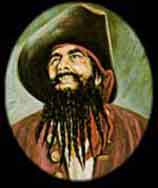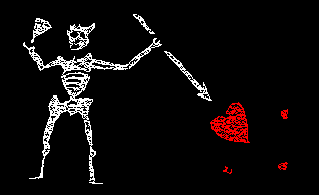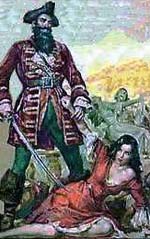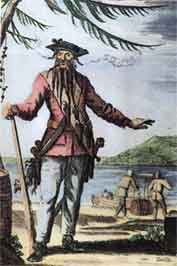Blackbeard
(1689 - 1718)

During The Golden Age of Piracy (1689-1718), numerous rogues pursued their lawless and murderous trade throughout the New World. Restrictive laws passed by the British Parliament had made smuggling acceptable and even desirable in North Carolina and the other American colonies. Preying upon lightly armed merchant ships, the pirates seized their contents and sometimes killed those who resisted. Despite a fierce reputation that has survived nearly three centuries, Blackbeard wouldn't be called a successful pirate. Those were rich men who died a quiet death at an old age.
Born Edward Teach, Blackbeard was the most notorious pirate in the history of seafaring. With a beard that almost covered his face, Blackbeard would strike terror into the hearts of his victims, according to some early accounts, by weaving wicks laced with gunpowder into his hair, and lighting them during battle. A big man, Blackbeard added to his menacing appearance by wearing a crimson coat, two swords at his waist, andbandoleers stuffed with numerous pistols and knives across his chest.
The sight of Blackbeard was enough to make most of his victims surrender without a fight. If they gave up peacefully, he would usually take their valuables, navigational instruments, weapons, and rum before allowing them to sail away. If they resisted, Blackbeard would often maroon the crews and burn their ship. Blackbeard worked hard at establishing his devilish image, but there is no archival evidence to indicate that Blackbeard ever killed anyone who was not trying to kill him.

In November 1717, in the eastern Caribbean, Benjamin Hornigold and Teach took a 26-gun, richly laden French guineyman called the Concorde (research indicated she had originally been built in Great Britain). Hornigold subsequently decided to accept the British Crown's recent offer of a general amnesty and retire as a pirate. Teach rejected a pardon, decided to make the Concorde his flagship, increased her armament to 40 guns, and renamed her Queen Anne's Revenge.
At its largest, Blackbeard's force included four ships and 300 or more men. The fleet assaulted mariners from the Caribbean to New England. North Carolina's coast offered several hideouts from colonial and British authorities.

An anchorage at Ocracoke is still called Teach's Hole. Bath was another Blackbeard haunt. Blackbeard's reign of terror climaxed in a week-long blockade of the port of Charleston, S.C. in late May 1718. One week later, the QAR was lost at Beaufort Inlet. One of the smaller vessels in Blackbeard's flotilla, the ten-gun sloop Adventure , was lost the same day while trying to assist the stranded flagship.
Blackbeard and his confidants had sailed to Bath, then the capital of North Carolina, where they received pardons from Governor Charles Eden of Virginia.
Knowing that Blackbeard and his men had continued taking ships long after the period of amnesty had expired, Eden called a Royal Navy contingent to North Carolina, where Blackbeard was killed in a bloody battle at Ocracoke Inlet on November 22, 1718. During the action, Blackbeard received a reported five musket ball wounds and more than 20 sword lacerations before dying. Blackbeard had captured over 40 ships during his piratical career, and his death virtually represented the end of an era in the history of piracy in the New World.
It was the custom of the times to display dead pirates as a deterrent to the occupation. Blackbeard's severed head was hung from the bow sprit of Maynard's ship.
Some Interesting Yet Little Known Facts About Blackbeard:
-

A Dutch flute similar to Queen Anne's Revenge
The British-built ship Concorde, was destined to become Blackbeard's Queen Anne's Revenge when she was captured somewhere off the Bahamas in 1717.
She was in the style of a Dutch flute, which had been a popular design for European merchant ships in the early 1700's.
Not content with the 26 cannons she was already carrying, Blackbeard increased the number to 40.
Little is known concerning the origin of Blackbeard the pirate. Documents suggest both Bristol and London in England, the island of Jamaica and even Philadelphia as his home. He is said to have operated out of Jamaica as privateer during Queen Anne's War (1702-1713) previous to having been a pirate.
- Historical sources vary as to Blackbeard's real name. Though most publications mentioning the pirate by name over the past couple of centuries have identified him as Edward Teach, the majority of primary source documents written during the time of his activities indicate that Thatch or some other phonetic derivation (ie, Thach, Thache, etc.), was actually the name he was going by at the time. The name Drummond is mentioned by one early source, but this not supported by the vast volume of other documentation.
- It appears that Blackbeard began his piratical career under the command of Benjamin Hornigold. Though Hornigold's activities as a pirate can be traced back to as early as 1714, it is not known for sure when Thatch joined his crew. The earliest mention of Blackbeard by name is in the Boston News-Letter in October 1717.
- Thatch and Hornigold captured a French slave ship called the Concorde off the island of St. Vincent around November 1717. Hornigold gave Blackbeard the ship and retired from piracy soon after. Thatch strengthened the armament of the vessel, renamed her the Queen Anne's Revenge and for the next 7 months used the ship in consort with smaller sloops to harass shipping throughout the Caribbean and up the eastern seaboard of North America.
- It is not currently known how many vessels Blackbeard captured during his exploits, but a preliminary database compiled by museum researchers currently contains over 45 prizes which can be directly attributed to Thatch's activities.
- Blackbeard was eventually tracked down to Ocracoke Inlet, North Carolina by the Royal Navy and killed in a brief, but bloody battle on 22 November 1718.

